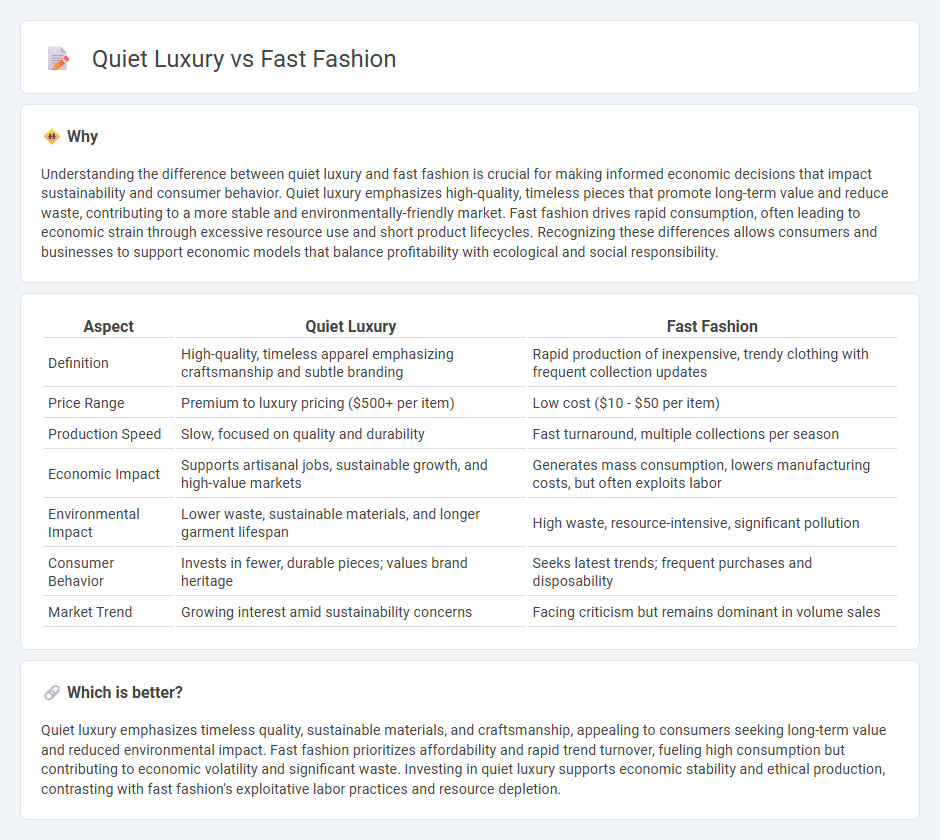
Quiet luxury emphasizes timeless, high-quality fashion pieces that prioritize durability and subtle elegance, contrasting sharply with fast fashion's rapid production of trendy, low-cost clothing consumed and discarded quickly. The quiet luxury market appeals to consumers valuing sustainability and long-term investment in apparel, while fast fashion drives mass-market sales through frequent style turnover and affordability. Discover how these opposing fashion economies impact consumer behavior and environmental sustainability.
Why it is important
Understanding the difference between quiet luxury and fast fashion is crucial for making informed economic decisions that impact sustainability and consumer behavior. Quiet luxury emphasizes high-quality, timeless pieces that promote long-term value and reduce waste, contributing to a more stable and environmentally-friendly market. Fast fashion drives rapid consumption, often leading to economic strain through excessive resource use and short product lifecycles. Recognizing these differences allows consumers and businesses to support economic models that balance profitability with ecological and social responsibility.
Comparison Table
| Aspect | Quiet Luxury | Fast Fashion |
|---|---|---|
| Definition | High-quality, timeless apparel emphasizing craftsmanship and subtle branding | Rapid production of inexpensive, trendy clothing with frequent collection updates |
| Price Range | Premium to luxury pricing ($500+ per item) | Low cost ($10 - $50 per item) |
| Production Speed | Slow, focused on quality and durability | Fast turnaround, multiple collections per season |
| Economic Impact | Supports artisanal jobs, sustainable growth, and high-value markets | Generates mass consumption, lowers manufacturing costs, but often exploits labor |
| Environmental Impact | Lower waste, sustainable materials, and longer garment lifespan | High waste, resource-intensive, significant pollution |
| Consumer Behavior | Invests in fewer, durable pieces; values brand heritage | Seeks latest trends; frequent purchases and disposability |
| Market Trend | Growing interest amid sustainability concerns | Facing criticism but remains dominant in volume sales |
Which is better?
Quiet luxury emphasizes timeless quality, sustainable materials, and craftsmanship, appealing to consumers seeking long-term value and reduced environmental impact. Fast fashion prioritizes affordability and rapid trend turnover, fueling high consumption but contributing to economic volatility and significant waste. Investing in quiet luxury supports economic stability and ethical production, contrasting with fast fashion's exploitative labor practices and resource depletion.
Connection
Quiet luxury influences consumer preferences by emphasizing timeless quality and subtle branding, challenging the fast fashion industry's focus on rapid trends and low prices. Fast fashion brands often mimic elements of quiet luxury aesthetics to attract affluent customers seeking affordable sophistication. This dynamic creates a competitive interplay where sustainable, high-end values meet mass-market accessibility, impacting overall economic patterns in the apparel industry.
Key Terms
Supply Chain
Fast fashion supply chains emphasize speed, cost efficiency, and high-volume production, often relying on offshore manufacturing and rapid turnover to meet constantly changing consumer trends. Quiet luxury supply chains prioritize quality, exclusivity, and sustainability, frequently sourcing premium materials and maintaining stricter control over production processes to ensure craftsmanship and ethical standards. Discover more about how these contrasting supply chain strategies impact brand value and consumer perception.
Consumer Behavior
Consumer behavior in fast fashion centers on demand for trendy, affordable clothing with rapid turnover, driving frequent purchases and disposability. In contrast, quiet luxury appeals to discerning consumers who prioritize durability, timeless design, and high-quality craftsmanship, resulting in selective buying and longer product lifecycle. Explore how these differing mindsets shape the fashion industry's future and sustainability trends.
Price Point
Fast fashion offers trendy clothing at low price points, typically ranging from $10 to $50 per item, making it accessible to a wide consumer base. Quiet luxury emphasizes high-quality materials and craftsmanship with price points often exceeding $500, reflecting exclusivity and timeless appeal. Explore the key differences in pricing and value to understand which style aligns with your wardrobe strategy.
Source and External Links
Fast Fashion - Fast fashion involves replicating high-fashion designs, mass-producing them cheaply, and bringing them to the market quickly to meet consumer demand for trendy clothing at low prices.
Fast Fashion Disaster - The fast fashion industry is highly profitable but has significant environmental and social impacts due to its practice of mass-producing cheap, low-quality clothes and fueling a disposable culture.
Fast Fashion's Environmental Impact - Fast fashion has a massive environmental impact, being the second-biggest consumer of water and responsible for about 10% of global carbon emissions.
 dowidth.com
dowidth.com